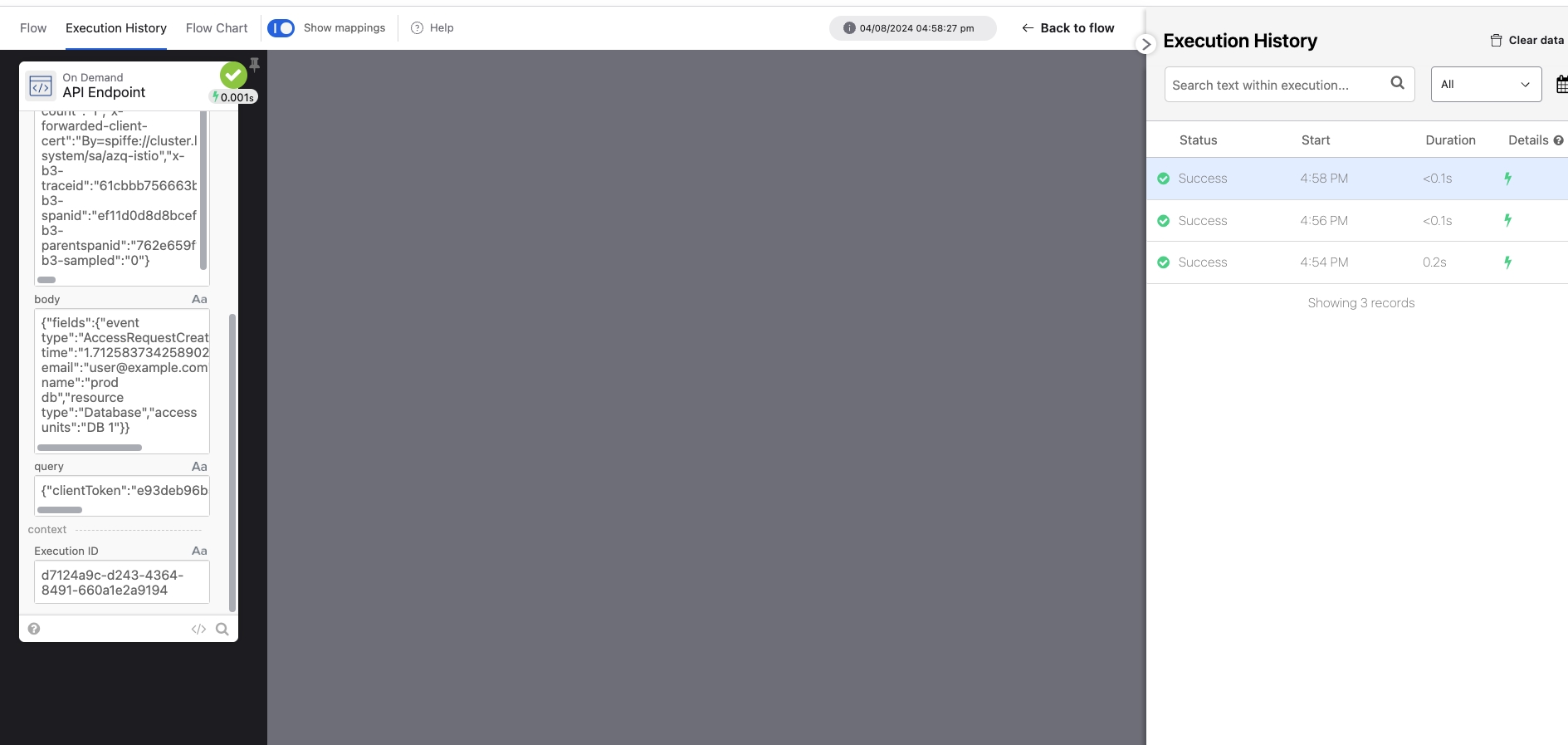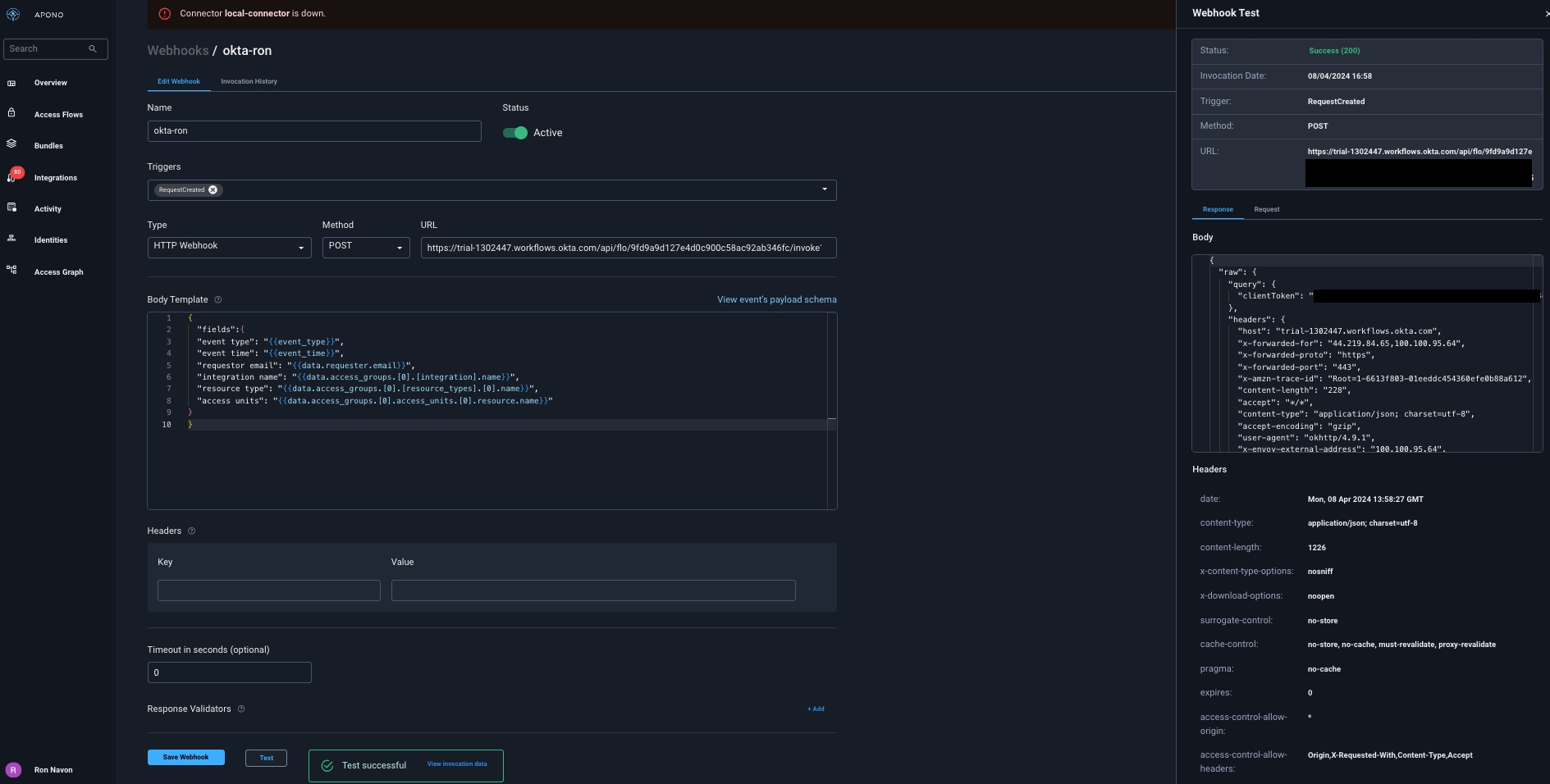
Apono outbound webhooks integrations with orchestration and workflow automation tools
Loading...
Loading...
Create an outgoing webhook in Apono that will send Apono access requests data to Torq Workflows
Torq is an AI-driven hyperautomation platform designed to help security teams automate processes quickly and efficiently. It offers features like pre-built integration steps, AI-generated workflows, and natural language chat for AI-augmented remediation of critical threats. Torq aims to enhance security operations by providing precision detection and machine-speed response.
This guide shows you how to configure and test outbound webhooks for Torq.
Torq token and copy the token to use it later.
Set up Torq webhook to create endpoint for Apono access request events and trigger workflows.
Follow these steps to configure a webhook:
On the Webhooks page, click Add Webhook. The Add Webhook page appears.
Click Request Webhook.
Enter a unique, alphanumeric, user-friendly Request Webhook Name for identifying this webhook.
Click the Status toggle to Active.
From the Method dropdown menu, select POST.
For the webhook URL, enter https://hooks.torq.io/v1/webhooks/<webhook-id>/.
In the Body Template field, paste the following JSON body for the webhook payload.
Click View event's payload schema to reveal the payload schema and available data fields. You can also refer to the Webhook Payload Schema Reference to read the descriptions of each data field.
For Headers, use the following Key and Value to set the authorization.
Authorization
Bearer <BASE64-TORK-TOKEN>
From the Triggers dropdown menu, select one or more of the following event triggers, which correspond to Apono access request statuses:
RequestCreated
RequestApproved
RequestExpired
RequestFailed
RequestGranted
RequestRejected
Under Filters, define one or several filter from the listed dropdown menus.
Filters empower admins to control the data transmitted via webhooks, minimizing the amount of data third-party tools receive and reducing unnecessary clutter.
Examples:
Send only production requests to your admins' Slack channel.
Trigger Okta workflows for events from specific integrations or resource types.
Open a ticket in Jira or ServiceNow for manually approved requests.
(Optional) In the Timeout in seconds field, enter the duration in seconds to wait before marking the request as failed.
(Optional) Define Response Validators to verify that the response from the webhook meets specified criteria:
Click + Add. A row of settings appears.
Starting with $.data., enter the Json Path of the JSON parameter.
In the Expected Values field, enter a value and press the Enter key on your keyboard.
Repeat step c to add several expected values.
Repeat steps a-d to add multiple response validators.
Click Test to generate a test event to trigger your webhook. A Test successful or Test failed response status will appear at the bottom of the page. A successful test will send mock data to the target system.
For more information about the test, click View Invocation Data. A panel opens revealing the request, response, and other relevant details.
Should your test fail, view these tips to troubleshoot your webhook.
Click Save Webhook.
The new webhook appears in the Webhooks table. Active webhooks are preceded by a green dot. Inactive webhooks are preceded by a white dot.
Apono access request logs will be sent to Torq Workflows based on the triggers you have selected.
Create an outgoing webhook in Apono that will send Apono access requests data to Okta Workflows
The steps below describe how to create an outgoing webhook in Apono that will send data on Apono access requests to Okta Workflows. Then, configure any workflow you'd like in Okta Workflows.
Permissions
Super admin with access to Okta Workflows
Configure your API endpoint settings
Follow these steps to configure API endpoint settings:
Create a flow in your Workflows Console and click Add event.
From the Pick an app to start your flow dialog, select API Endpoint.
In the API endpoint settings dialog, select Secure with OAuth 2.0 as the security level.
Follow these steps to configure a webhook:
On the Webhooks page, click Add Webhook. The Add Webhook page appears.
Click Request Webhook.
Enter a unique, alphanumeric, user-friendly Request Webhook Name for identifying this webhook.
Click the Status toggle to Active.
From the Method dropdown menu, select POST.
In the URL field, enter https://<DOMAIN>.workflows.okta.com/api/flo/<CLIENT_TOKEN>.
Be sure to replace <DOMAIN> with your company domain and <CLIENT_TOKEN> with the clientToken generated in Okta Workflows.
The webhook URL must adhere to the following requirements:
Uses the HTTPS protocol
Does not specify any custom ports
In the Body Template field, construct a JSON body for the webhook payload.
Click View event's payload schema to reveal the payload schema and available data fields. You can also refer to the Webhook Payload Schema Reference to read the descriptions of each data field.
(Optional) Under Headers, use the following Key and Value value to set the header. You can set the clientToken as a header value instead of passing it in the URL in step 6.
Be sure to replace the <CLIENT_TOKEN> placeholder.
x-api-client-token
<CLIENT_TOKEN>
From the Triggers dropdown menu, select one or more of the following event triggers, which correspond to Apono access request statuses:
RequestCreated
RequestApproved
RequestExpired
RequestFailed
RequestGranted
RequestRejected
Under Filters, define one or several filter from the listed dropdown menus.
Filters empower admins to control the data transmitted via webhooks, minimizing the amount of data third-party tools receive and reducing unnecessary clutter.
Examples:
Send only production requests to your admins' Slack channel.
Trigger Okta workflows for events from specific integrations or resource types.
Open a ticket in Jira or ServiceNow for manually approved requests.
(Optional) In the Timeout in seconds field, enter the duration in seconds to wait before marking the request as failed.
(Optional) Define Response Validators to verify that the response from the webhook meets specified criteria:
Click + Add. A row of settings appears.
Starting with $.data., enter the Json Path of the JSON parameter.
In the Expected Values field, enter a value and press the Enter key on your keyboard.
Repeat step c to add several expected values.
Repeat steps a-d to add multiple response validators.
Click Test to generate a test event to trigger your webhook. A Test successful or Test failed response status will appear at the bottom of the page. A successful test will send mock data to the target system.
For more information about the test, click View Invocation Data. A panel opens revealing the request, response, and other relevant details.
Should your test fail, view these tips to troubleshoot your webhook.
Click Save Webhook.
The new webhook appears in the Webhooks table. Active webhooks are preceded by a green dot. Inactive webhooks are preceded by a white dot.
Apono access request logs will be sent to Okta Workflows based on the triggers you have selected.
Your webhook should now start sending events payloads to the workflow once triggered.

